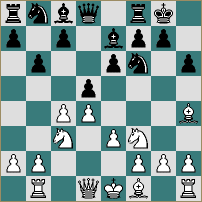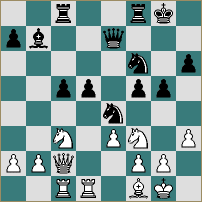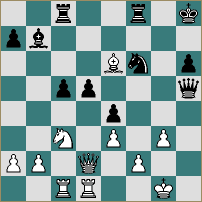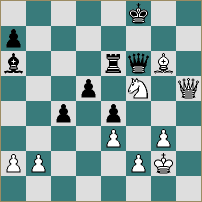Battle of the Jonathans
Jonathan Levitt - Jonathan Parker
This game put me in the lead after nine rounds at the British Championships in Swansea, 1995. I went on to lose to Matthew Sadler in the last round, so my ambition to win the British remains unfulfilled. Annotations adapted from those that appeared in Chess Monthly. 1 d4 Nf6 2 c4 e6 3 Nc3 d5 4 Bg5 Be7 5 e3 0-0 6 Nf3 h6 7 Bh4 b6 8 Rb1I was trying to bring the rook to the c-file but my hand slipped...Actually this move is the suggestion of a well known Ukrainian grandmaster known by some in the west as ‘slimegorn’. It is probably best for me to get my plug in for Secrets Of Spectacular Chess straight away (then it will be off my mind), so here goes... I find the move very appealing, probably because of its depth and paradox - two of the four key elements put forward in the fascinating theory of chess aesthetics outlined in SOS, which incidentally makes an ideal Christmas present. 8 Rb1 is clearly a rather sneaky move and at first sight it looks a little absurd (or ‘mysterious’ as Nimzovich would have it). Its depth and purpose are revealed in the following variations: 1) 8...Bb7 9 Bxf6 Bxf6 10 cxd5 exd5 11 b4 and the rook is well enough placed on b1. 2) 8...Ba6 9 Bxf6 Bxf6 10 cxd5 Bxf1 11 Kxf1 exd5 12 Qb3 c6 13 g3 with a slight edge for white. 3) 8...c5?! 9 dxc5 bxc5 (9...Bxc5 10 cxd5 exd5 11 Bxf6 Qxf6 12 Nxd5 and the rook defends b1. Thus White nets a whole pawn with every prospect of a quick win and sufficient time to squeeze in a much needed shampoo before the next round.) 10 cxd5 Nxd5 (10...exd5 11 Bxf6 Bxf6 12 Nxd5 Qa5+ 13 Qd2 Qxa2 14 Nxf6+ gxf6 15 Rc1) 11 Bxe7 and your opponent will be left with a nagging pawn weakness. The game continuation is a more reasonable option for Black. 8...Ne4 9 Bxe7 Qxe7 10 Qc2 Bb7 11 cxd5 exd5 12 Bd3? Not consistent. It was correct to make use of the rook on b1 with 12 b4 which would also have set a tactical trap:
12 b4 c5? 13 bxc5 bxc5 14 Nxe4 dxe4 15 Qxc5! 12...c5! 13 0-0 Nd7 14 dxc5 bxc5 15 Rfd1 Not 15 Bxe4? dxe4 16 Nd2 Ba6 17 Rfd1 Bd3, losing the exchange. 15...f5! 16 Bf1 I had been hoping there might be a trick in this position, but closer examination revealed a serious flaw: 16 Bxe4? fxe4 17 Nxe4? Qxe4! 18 Qxe4 dxe4 19 Rxd7 Bc8!, winning a piece. Black has at least equalised and can now expand on the kingside. 16...Ndf6 17 h3 g5 18 Rbc1 Rac8V. Eingorn, 2595, has no reason to be proud of me. Not only have I been disrespectful in these notes but I have also made his novelty look silly. The rook surreptitiously makes its way to c1 - where it normally goes on move eight - but my opponent was sufficiently polite not to stare or giggle at this stage (as I would have done). Probably my GM title was finally coming in useful... 19 Nd2 g4?! After this White has good chances again. ‘Stronger, more evil and more profound; also more beautiful’ (Nietzsche) would have been 19...Nxf2!?, but 20 Kxf2 d4 21 Re1 is playable if there is nothing better. Thematic would have been 19...Nxc3 20 Qxc3 f4, looking to increase the strength of the hanging pawns, after which I prefer Black. 20 Ndxe4 fxe4 21 g3 Qe5 22 Qd2 gxh3 23 Bxh3 Qh5 24 Be6+ Kh8 25 Qe2?! I was not at all interested in taking the exchange, but I should have looked more deeply at 25 Ne2! Ng4 26 Bxg4 Qxg4 27 Nf4. I was worried by 27...Rxf4, missing that after 28 exf4 d4? White has 29 Rxc5! 25...Qg5 More worrying was 25...Qe5!?, when I would have grabbed the exchange and hoped for the best rather than just allowing Black to be better with 26 Bh3 d4! Time trouble dominates the next series of moves. The talented young Cambridge student goes wrong somewhere in the middle of it, since my exchange sacrifice (move 36) is too dangerous to be allowed. 26 Na4 c4 27 Nc3 Rce8 28 Bh3 h5 29 Kg2 Rf7 30 Nb5 Rg7 31 Rh1 Qe5 32 Nd4 Ba6? 33 Rh2 Kg8 34 Rch1 Kf8 35 Bf5 Rg5 36 Rxh5! Nxh5 37 Rxh5 Rxh5 38 Qxh5 Qf6 39 Bg6 Re5 40 Nf5 Re6 Move 40 having been reached there was now time to think. One thing that experience teaches - and I’m not convinced it teaches all that much - is that you must take time out to regain your calm and composure in situations like these. After a stressful flurry of moves before the time control it took me some ten minutes or so to achieve the desired state of mind. At first I thought White had no more than a draw by perpetual check, but then I realised that Black was not in fact threatening to take the bishop and so there is time to bring another unit into the attack. It is White to play and win if you wish to test yourself. 41 Qh6+ Kg8 42 g4!! When I played this I knew the game was mine and that I would be outright leader with two rounds to go. Such thoughts usually spoil your chances, but here the position was just too good. 42...Bc8
The point is that 42...Qxg6 is met by 43 Ne7+! Black is helpless. 43 g5! Qxg6 The alternatives were 43...Qe5 44 Qh7+ Kf8 45 Qf7# and 43...Qh8 44 Bf7+! 44 Ne7+ Kf7 45 Nxg6 Rxg6 46 Qh7+ Rg7 47 Qh4 Bf5 48 Qf4 Ke6 49 Kf1 Rb7 50 Qh2! Bg6 (50...Rxb2? 51 Qh6+) 51 Qh8 Rf7 52 Qd8 Kf5 53 Qxd5+ Kg4 54 Ke2 Rh7 55 Qe5 Rf7 56 a4 Kh5 57 Qc5 Rb7 58 Qe5 a5 59 Kf1 Rb4 60 Kg2 Rxa4 61 Kg3 Ra1 62 f4 and Black resigned.



